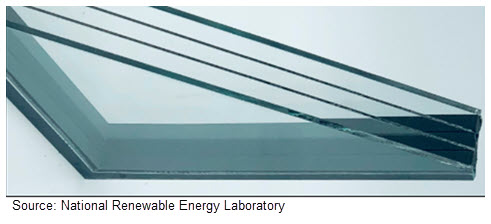
Every year, the E Source Customer Energy Solutions team highlights the top 20 utility technologies and trends that caught our attention. This year had no shortage of new developments with utilities responding to major climate events and equity concerns with a sense of urgency.
The federal government passed major infrastructure legislation to help utilities improve grid resiliency, EV charging infrastructure, and the development of distributed energy resources. More utilities than ever are launching electrification initiatives for buildings and fleets. And the industry saw key technological developments in thin-paned windows and distributed energy resource management systems (DERMSs).
Here’s a peek at a few of the top techs and trends from our annual report.
Thin quadruple-paned windows show promising energy savings and costs
Spencer Sator
This year brought new developments in window treatment technologies like:
- Low-E window film (like we write about in Are advanced low-e window films valuable for DSM programs?)
- Interior storm windows (like the WexEnergy product we described in Spring 2021 tech roundup)
- The first-ever exterior secondary window product (the INOVUES product we describe in Spring 2021 tech roundup)
But the biggest development in 2021 wasn’t about making existing windows more efficient—it was a breakthrough study on a new technology to replace windows altogether.
In November 2021, the US General Services Administration (GSA) and the National Renewable Energy Laboratory (NREL) published their joint study on Lightweight Quad-Pane Windows, also known as thin quadruple-paned windows (figure 1). The researchers found that thin quadruple-paned windows saved 19% to 33% in HVAC energy compared with high-performance double-paned windows. And the thin quadruple-paned windows are nearly the same cost.
Figure 1: Cutaway view of a quadruple-paned window
By using thin glass for internal layers instead of standard window glass, the windows remain lightweight and can fit in cavities designed for standard double-paned windows. The first version of thin quadruple-paned windows has only been on the market for about three years. And thin windows only became economically feasible in recently because of the mobile phone industry, which brought down the cost of thin, strong, lightweight glass.
Only one manufacturer, Alpen, currently makes these windows. And the study from GSA and NREL is the only evaluation of the technology so far. But if these findings prove to be true, utilities could see a big increase in the cost-effectiveness of their window incentive programs. The industry needs more evaluations and products before we’ll see widespread adoption.
DERMSs get real in 2021
Bryan Jungers
This year we saw major progress from utilities in scaling their commercial DERMS solutions. DERMSs are critical to the optimized control and coordination of distributed energy resources (DERs) on the grid.
In the past, utility DERMS deployments have been limited in scale and focus. And they often served only a small subset of customers or DERs. DERMS are expensive and can take utilities many years to build. But new utility DERMS solutions are delivering more DER value for utilities and customers. We expect these DERMS to become plug-and-play solutions for managing DERs in the future.
This year, EnergyHub deployed its Mercury DERMS solution in partnerships with utilities across the US and Canada. Through the platform, EnergyHub helps deliver load flexibility and demand management for behind-the-meter batteries and EVs with its Energy storage solutions and Electric vehicle charging solutions. Arizona Public Service (APS) successfully used Mercury to deploy a virtual power plant via the utility’s bring-your-own-thermostat (BYOT) Cool Rewards program, as explained in its press release on the topic. And APS uses Mercury to determine which products are eligible for its Residential Battery Pilot program. Only products compatible with the DERMS can enroll.
In another development, Generac Grid Services is working with Eversource to demonstrate BYOT and battery-management capabilities with its Concerto platform. Eversource has since expanded its ConnectionSolutions program, which was originally a smart thermostat program, to include a ConnectedSolutions Demand Response offering for battery storage DR and ConnectedSolutions EV offering for EVs. Eligible communicating chargers include models from ChargePoint and Enel X, as well as the combined solar inverter and EV charger from SolarEdge.
More states and provinces launch substantial building-electrification initiatives
Barend Dronkers
California, New York, and Massachusetts all made a splash this year with building-electrification program announcements, all of which had an emphasis on heat pumps. All three initiatives:
- Include heat-pump awareness and familiarity campaigns to target early adopters
- Invest in midstream incentives to stock shelves with affordable heat pumps
- Give incentives and training on building electrification for contractors, installers, and distributors
In California, the Technology and Equipment for Clean Heating initiative is a new $120 million coordinated effort to transform the market for residential heat pumps across the entire supply chain. It combines large midstream incentives–up to $6,000–with well-funded consumer awareness and education campaigns.
In New York, on January 5, 2022, Governor Kathy Hochul announced a new climate plan to electrify at least 1 million homes and make another 1 million electric-ready by 2030. Read more about it in NY governor unveils plan to electrify homes, achieve zero-emissions construction. This plan is on top of $2 billion in funding for utility-led clean heating and cooling efforts through the existing New York State Clean Heat statewide heat pump program. The New York State Energy Research & Development Authority also leads market development programs with a plan to invest $1.2 billion in energy efficiency and heat pumps by 2025.
In Massachusetts, the new Mass Save Three Year Energy Efficiency Plan: 2022-2024 (PDF) includes incentives for customers who install heat pumps with weatherization measures.
We expect to see other utility electrification initiatives support contractors and distributors with strong trade ally networks. These networks should develop relationships with heat pump manufacturers and give heat pump incentives and training for contractors.
States change cost-effectiveness calculations to capture more impacts
Jesse Hitchcock
This year utilities made changes to their cost-benefit analyses to better reflect the total value of efficiency, demand reduction, and electrification. California, Massachusetts, and Hawaii are three examples of states that changed the way they evaluate programs this year.
California started using a total system benefit (TSB) metric to capture impacts outside of energy savings in May 2021. The TSB is measured in dollars and replaces kilowatt-hour, kilowatt, and therm savings. It rewards utilities for optimizing energy use based on the time of day. It also encourages utilities to focus on energy savings that have a greater impact on avoided costs, such as energy savings from end uses with high global warming potentials or high greenhouse gas emissions.
In Massachusetts, Governor Charlie Baker signed the Act Creating a Next Generation Roadmap for Massachusetts Climate Policy into law in March 2021. The law requires all energy-efficiency program administrators to include the social cost of carbon in their cost-effectiveness testing. Massachusetts utilities are now rewarded for delivering electrification programs that replace carbon-intensive fuels, not just for reducing demand.
In June 2021, the State of Hawaii Public Utilities Commission (PUC) approved new performance incentive mechanisms (PIMs) for utilities as part of the state’s performance-based regulation system. Ideally, PIMs:
- Define a goal for a utility to strive for
- Determine the metric that the utility will use to measure its success
- Set the incentive that the utility will get if it meets the goal
This spring, the Hawaii PUC worked with stakeholders to choose the PIMs that reward utilities for working toward goals involving DERs, low-income customers, and renewable energy. The Hawaii PUC press release Hawaii PUC Approves Portfolio of Performance Mechanisms for Hawaiian Electric gives details on the new PIMs.
